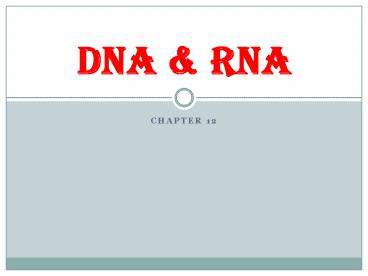DNA - PowerPoint PPT Presentation
1 / 24
Title:
DNA
Description:
DNA & RNA CHAPTER 12 Griffith & Transformation Discovered transformation using bacteria that causes pneumonia Transformation Process in which part of the nucleotide ... – PowerPoint PPT presentation
Number of Views:32
Avg rating:3.0/5.0
Title: DNA
1
DNA RNA
- Chapter 12
2
Griffith Transformation
- Discovered transformation using bacteria that
causes pneumonia - Transformation
- Process in which part of the nucleotide sequence
of DNA is copied into a complementary sequence in
RNA
3
Avery DNA
- Retested Griffiths experiment to determine what
caused transformation - Discovered that the nucleic acid in DNA stores
and transmits the genetic information from one
generation of an organism to the next
4
Hershey-Chase Experiment
- Studied viruses
- Concluded that DNA was the genetic material of
bacteriophages, not protein
5
Components Structure of DNA
- DNA is made up of Nucleotides
- Each nucleotide is made up of 3 basic components
- 5 carbon sugar (deoxyribose)
- A phosphate group
- Nitrogenous base
- 4 nitrogen bases
- Adenine
- Guanine
- Cytosine
- thymine
6
Chargaffs Rule
- The observation that A T G C
- Found that in 4 different types of organisms the
amount of A T were nearly the same as well as
the amount of G C were nearly the same.
7
Double Helix
- Watson Crick built a 3-D model of DNA based on
the evidence found by Franklin using X-ray. - Found that DNA was a double helix, in which two
strands were wound around each other resembling a
spiral staircase - Hydrogen bonds hold the two strands together but
only formed between AT and GC - This is called base pairing
8
12-2 Chromosomes DNA Replication
9
DNA Replication
- Each strand of the DNA double helix has all the
information needed to reconstruct the other half
by the mechanism of base pairing. - Replications proceeds in both directions until
each chromosome is completely copied
10
(No Transcript)
11
Duplicating DNA
- Before a cell divides it duplicates DNA
- During duplication, the DNA molecule separates
into 2 strands, produces 2 new complementary
strands based on base pairing.
12
How Replication Works
- Replication is carried about by many enzymes, the
principle enzyme is DNA polymerase - It joins individual nucleotides to produce a DNA
molecule - Proofreads each new DNA strand
13
12-3 RNA Protein Synthesis
14
The Structure of RNA
- Consists of a long chain of nucleotides
- 3 main differences between RNA DNA
- The 5 carbon sugar is ribose, not deoxyribose
- RNA is generally single stranded
- RNA contains uracil instead of thymine
15
Types of RNA
- RNA has many functions, but in the majority of
cells most RNA molecules are involved in only one
thing PROTIEN SYNTHESIS - 3 main types of RNA
- Messenger RNA (mRNA)
- Ribosomal RNA (rRNA)
- Transfer RNA (tRNA)
16
Types of RNA
- Genes contain instructions for assembling amino
acids into proteins - RNA molecules that carry copies of these
instructions are known as mRNA - Proteins are assembled on the ribosomes.
Ribosomes are made up of several dozen proteins
as well as a form of RNA called rRNA - During protein construction, a third type of RNA
molecule transfers each amino acid to the
ribosome as it is specified by coded messages in
mRNA. This is known as tRNA.
17
Transcription
- RNA molecules are produced by copying part of the
nucleotide sequence of DNA into a complementary
sequence in RNA. This is called transcription. - Requires RNA polymerase
- RNA polymerase binds to DNA and separates the DNA
strands. RNA polymerase then uses one strand of
DNA as a template from which nucleotides are
assembled into a strand of RNA.
18
RNA Editing
- DNA of eukaryotic genes contains sequences of
nucleotides called introns that are not involved
in coding for proteins. - The DNA sequence that code for proteins are
called exons because the are expressed in the
synthesis of proteins. - When RNA molecules are formed they copy both the
introns and exons.
19
The Genetic Code
- The language of mRNA instructions is called the
genetic code. - A codon consists of 3 consecutive nucleotides
that specify a single amino acid that is to be
added to the polypeptide - There are 64 possible the base codons
- During translation, the cell uses information
from mRNA to produce proteins
20
Mutations Gene Regulation
21
Kinds of Mutations
- Mutations are changes in the genetic material
- Point Mutations gene mutations involving
changes in one or few nucleotides - Include
- Substitutions
- Insertions
- Deletions
- Frameshift Mutations shift the reading frame
of the genetic message
22
Examples
- Point
- The fat cat ate the wee rat.
- The fat hat ate the wee rat.
- Frameshift
- The fat cat ate the wee rat.
- The fat caa tet hew eer at.
23
Chromosomal Mutations
- Involve changes in the number or structure of
chromosomes - May change locations of genes on chromosomes
- 4 types
- Deletions
- Duplications
- Inversions
- Translocations
24
Examples
- Original
- ABCDEF
- Deletions
- ACDEF
- Duplications
- ABBCDEF
- Inversion
- AEDBBF
- Translocations
- ABCJKL
- GHIDEF































